 April/May 2021 - Vol. 34, No. 6.
April/May 2021 - Vol. 34, No. 6.
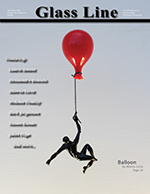
|
In This Issue
An Apple Paperweight by Naomi Kondo
The theme of fruits and flowers is popular, but I create my own versions by incorporating techniques of precise work and delicate finish, and by using color shading and fine lines from the petals toward the hearts, as well as simple patterns with elaborate finishes.
I never learned to use an oxygen burner, so I have made many mistakes to create my current work. However, I think I was able to achieve the work I wanted to create because I didn’t learn from anyone else. I am ready to make many more mistakes in the future and would like to try new types of projects...

Sculptural beads can be a lot of fun to make. Never tried it? There’s no time like the present. The beauty of something like a fish bead is that it doesn’t have to be round — ever. Fish come in a variety of body shapes, from the disc-shaped discus to the pointed gar, so whatever shape your base bead is, you can probably make it into a fish body. Although I sometimes make fish that are more realistic, most of the fish I make are “fantasy fish.” This means I can add colors and designs as I like and not have to worry about the fish experts in the crowd.
The difficult thing about sculptural beads is learning the “dance” that will keep your bead warm so it doesn’t crack while you’re working out the details, so remember to flash it in the flame often. In this case, flashing means running through the flame just enough to keep the bead warm through and through, without accidentally melting things that you don’t mean to melt. Flash the bead after you add each new element or finish each shaping step.
The silver core in this fish will make it a little more prone to cracking. Pretty much any time you include something in a bead that is not glass, it will increase the likelihood of a thermal crack. It is certainly not necessary to include the silver but it does give the fish a nice shiny scaly look.
This fish does not require a lot of fancy tools.
...

I have to be content with making work that is not very large, and that I can do in stages to put together later. I do ocean scenes where I can make coral, fish, anemones, seahorses, seaweed, etc., and keep all the elements until I’m ready to put them together on a piece of driftwood or rock. Smaller compositions can go on a glass base with the other elements attached by having them hot and ready in the kiln. I have made toadstool scenes with spiders, scorpions, ants, dragonflies, and flowers, also on pieces of wood. Sometimes I will blow the toadstool base in borosilicate glass, but fuse and slump soft glass for the toadstool cap and then attach them together. I have no problem combining different methods to make a composition.
I have been making dragon-type characters for a while now. I can do the tail, legs, feet, and wings and let them cool slowly between fiber blankets. When I have several components, they go into the kiln to be annealed, along with the head and sometimes the body as well to heat up and attach all together at a later time.
Learning new techniques and watching how others do their glass art is fascinating. At the moment, I’m going back to boro basics with Uncle Roger on Patreon. I can only work small, but it’s still intriguing to watch and learn different ways of doing things. You can never stop learning...

At the beginning, what attracted me most about glasswork was shaping and sculpting, because I naïvely thought that was the perfect way to give expression to my ideas, but soon I understood that glass has its own rules to be followed and I had to fit into them by trying to explore them.
I didn’t realize that the journey was so long, but it has also been exciting at the same time. Only recently, glass gave me a way to express myself and now I have the courage to embark on a more–challenging path.
When I begin a new piece, I observe every single step carefully to make cleaner, and only essential, movements...

I hope that one day I will have the skills to make a handful of recognizable Scottish species. I am always trying to think beyond jewelry for cabochons, especially trying to come up with something that I could wear myself (in the wind and rain, with woolly-pullys and outdoor gear). I persuaded my other half to use his wood working skills to make a hair-slide to take cabochons, and I wear this most days. So I will continue doing what I do and I will continue to admire the work of others, and hope that some of you out there will benefit from my tutorial.
Making a cabochon (cab) is, on the face of it, is quite simple because it takes only a few steps. However, these need care and precision, so it is ideal for honing basic skills (and exposing any weaknesses in those skills). I use a Carlisle mini-CC torch on an 8 L oxygen concentrator; Hothead users could try with a smaller cabochon size.
This flower has petals arranged in pairs, giving it a different look from single petals, but single petals work equally well...

I recently built a little glory hole on the side of the my torch, which allowed me to achieve results that I could not have imagined years ago.
Lately, I designated my studio as a school, since my technique has been receiving great interest. Lots of people want to take on glassblowing and lampworking, and I am glad to teach them.
My work is still to be discovered by a wider audience. Without sharing there is no development, so my studio is open to anyone...

Amalgamation is a style that is suitable for bead sets or focals (image 1) and combines several techniques in a unifying color palette into a single element. Combining a selection of amalgamation beads into a set makes a statement. While each individual bead has a limited canvas size, the variations in basic design elements and colors across the collection create a cohesive set. By using a variety of encased stringers, dots, stripes, twists, and swirls, amalgamation beads are conducive to any color palette.
When designing a bead set, I generally pick the color palette first, using an inspirational photo or item, and decide which is to be the dominant color and which will play supporting roles. Consider both the range of colors compared to the color wheel, and the variation in color intensity across the selected palette. In these examples, pink is the dominant color, with white, greens, teals, and gray in supporting roles...
|
 February/March 2021 - Vol. 34, No. 5.
February/March 2021 - Vol. 34, No. 5.
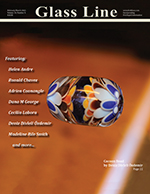
|
In This Issue
Rosebud by Helen Andre
These little rosebuds are very robust, even in charm bracelets, where they can safely clink together; perfect for earrings and pendants, and can be made in any color combination you fancy. Usually I make the base in an opaque and the petals in a contrasting transparent, but other combinations work well, too, like Opalino or alabaster petals and some of the lovely translucent CIM colors.
My leaf cane is made with CIM Dirty Martini, Reichenbach deep black and Effetre transparent sage green.
Throughout this project, it is necessary to keep the bead hot. We all know what happens if the bead gets cool
...

I work in the traditional lampwork style for most small forms. I also work off-mandrel using a blowpipe, which provides me with the freedom to create a variety of forms, including tubes and non-round shapes. Other techniques include cold work and acid etching.
When making glass beads, I work primarily with soda-lime, but for a period of time I delved into borosilicate glass. Depending on the look that I am after, I may also use metal foils, enamels, dichroic glass, and/or glass frit because these materials will affect the final outcome of the beads.
My beads range in color and style from colorful and funky to more-organic neutral tones with classic designs. My style is so varied because I use all of the beads that I make for jewelry design and I want the freedom to design in many styles. My jewelry pieces are mostly one of a kind. My focus is to make timeless, beautiful, wearable jewelry pieces that will become treasured heirloom jewelry
...

Do you even dichro?
Dichroic can be applied on top of linework tubing to make linework dichroic tubing. It takes a small amount of stock and turns it into a lot more. This could be useful for anyone wanting to stretch their linework tubing a lot farther, but with all that dichroic bling.
I came up with this one day while trying to figure out how to make linework dichroic tubing on my own and was surprised how much stock I got from using a 4” or 5” section of linework. This demo involves applying dichroic strips on opposing sides of a four-way linework pattern. You can use this process to apply dichroic on all sides, over color tubing, or over solid. You can even alternate different colors of dichroic for each pattern.
You will probably trap air at first while you are honing your skills, but practice makes perfect. If you are good at laying down dichroic or clear, then this should be easy for you. Even I trap minimal air now, but I know how to control these little inconsistencies so they don’t really affect my final prep. I hope you can learn a trick or two and find this useful in your work
...

I believe that the learning process of glass is never-ending. I do my best to learn something new every day.
Nature inspires me. That is why I love making murrini and reflecting the colors and themes of nature in my works. With my murrini, I design flower gardens, colorful landscapes, vivarium, and galaxy beads. For the past year, I have been making beads and marbles with colored dots and the implosion technique for my new collection, which I call Cocoon ...
Hummingbird by Adrien Connangle
This demonstration shows how to make a hoop from a stretched point and a hummingbird by preforming sections and attaching them together
...
Instruments for Interaction-
Creating Musical Devices Through Glass by Madeline Rile Smith
I make glass instruments that alter the body’s relationship to space. I’ve always been interested in the unique ability of glass to create sound, optics, and vibration, and in my work, I draw on these qualities to create interactive objects, including absurdist musical instruments and wearable devices for performance art. Sometimes these pieces draw a reaction of surprise or shock, which is all part of the fun
...
Brushflower by Dana M George
This is a fairly new design that I only recently started making. It is a light and airy floral design with a delicate, feminine look to it. I enjoy the challenge it presents in heat control and dot placement. It also provides me with my favorite pastime: choosing a color scheme. I like to go with gradients for this design, but feel free to go in whatever direction your heart leads
...
|
 December/January 2020/21 - Vol. 34, No. 4.
December/January 2020/21 - Vol. 34, No. 4.
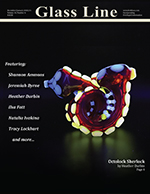
|
In This Issue
Octolock Sherlock by Heather Durbin
I discovered glass when I was a new stay-at-home mother, making jewelry for diaper money. I became interested in the medium when I was searching for an affordable way to replenish my bead stash, which is laughable now because glass has become an addiction for me. This lifestyle has enriched my existence in so many ways, from learning patience with every lesson of trial and error to traveling to shows, charities, and galleries to marvel at other artists’ talents and, of course, the flame-offs.
This medium opened my eyes to a magical world that only dreams are made of. I would love to express my gratitude to all who have helped make my dreams a reality.
I usually make two of these at a time because a lot of kiln time is involved. In this piece, I demonstrate encasement, honeycombs, hollow curls, webbing, tentacle cups, disks, and the importance of blowhoses, bridging, and hand torches...

Currently, I work with SOE 104 glass, mainly without mandrels and separators due to the additional features of this method. I like to mix a lot of different materials. Sometimes it’s difficult to resist and not exceed the size of the bead suitable for the pendant.
Glass is an inexhaustible source of inspiration. This option for creating an iridescent bead with a star-shaped cubic zirconia will take about 1.5 to 2 hours...

The marble cullet I used had been buried in the ground for decades and dug up by die-hard marble collectors. It is very difficult to “re-melt” this glass and anneal it properly into a finished marble that doesn’t fracture or simply fall apart. It’s also challenging to get the right torch settings that don’t discolor or burn up the old glass. I accomplished both with no lessons or guidance from other glass artists; I claim divine inspiration as the only explanation to my success.
I was so successful that some well-known artists challenged me, saying I was lying about the marbles I was now selling in large quantities. They said, “There is no way a new glass artist can do what you claim. Some artists with many years on the torch can’t do it!” I was even banned from some of the largest marble-selling sites on Facebook, which had become my main source for sales after eBay.
The technique I use to make antique cullet marbles is not for everyone, but if you ever want to try it, this should get you something you’ll be happy with. I also use this technique to repair broken marbles or make marbles out of Grandma’s fancy antique drinking glasses when one breaks. One reminder: This will only work on soft glass ranging from 93 to 106 COE +/-.
I’ve worked with every type of glass now, and the antique cullet marbles are still my favorite to make. There’s something very satisfying about watching something old and discarded become something new and beautiful...

In the 10 years of my continuous glasswork, what keeps me going is the sense of exploration: the combination of frustration and delight. Frustration when everything goes wrong and my grandiose ideas turn out to be unworkable disasters, which just makes me want to plunge right in and find another way to solve the problem. Delight when something does work, often in an unexpected way that offers new possibilities and new routes to explore.
I’ve evolved from wanting to make beads for jewelry to making more-figurative work. Reptiles and amphibians feature regularly, as do coral reefs and marine invertebrates.
Although I work exclusively in soft glass, I am increasingly drawn to borosilicate artists. Much of my current work uses techniques often associated with borosilicate glass, such as implosions and vortices. I’m not ready to change my torch setup and abandon my precious hoard of soft glass and accumulated soft-glass knowledge, but maybe that will be an adventure yet to come...

I’ve always been passionate about art in all aspects and used to make clay sculptures as a hobby. A good friend showed me lampworking and I fell in love. I’ve been blowing glass for a little over two years. It’s definitely a hard medium to use, but worth all the trial and errors. I try to get inspiration from nature and always liked the concept of life and death, so a lot of my work is base on that. I mostly make solid sculptures like flowers, scorpions, and animals, but like to make hollow sculptures as well as my raven skulls...

I have been torching since 2010 using a Hot Head torch and continue to develop my techniques as there are so many sources of instruction and expertise available. I’ve used a few other “big girl” torches during classes and studio time, but as part of a military family re-locating often, I’ve found that the Hot Head is my best option. I do plan to upgrade my torch setup once we are settled into our permanent location within the next few years.
With the coming holidays, I thought I’d share one of my favorite lampwork techniques with you: making berry headpins. They are fairly simple to create and are perfect for this time of year, but do take a bit of practice. You can use them as accent pieces for jewelry, tiny bouquets, decorations for ornaments, or any other small craft project. Their use is limited only by your imagination.
I tend to find my inspiration from nature. I enjoy horseback riding and hiking, and I’m always on the lookout for new ideas while out exploring. The trails where I ride have an abundance of flora and fauna, and the berries have been a lovely sight to behold this year. There are American Beauty Berry, Yaupon Holly, Heavenly Bamboo, Inkberry, Pyracantha, and many more. I believe inspiration can be found anywhere — you just have to look around to notice and appreciate it...
|
 October/November, 2020 - Vol. 34, No. 3.
October/November, 2020 - Vol. 34, No. 3.
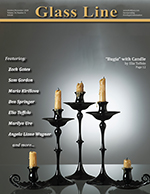
|
In This Issue

I never considered myself to be an artistic individual before this, but I saw endless possibilities in this medium. Watching gold and silver fumes create every color of the rainbow seemed unreal. I will never forget the nervous excitement I experienced when I first felt glass melt. I still often feel that way when pushing out of my comfort zone.
Now, after two years flameworking, I devote my time, efforts, and full artistic energy toward fuming and linework. I found Salem Community College and immediately a degree in scientific glassblowing became the primary goal on my horizon. This path allows for artistic exploration and enjoyment in my free time, as well as the pursuit of a full-fledged career in scientific glass work.
Most importantly, throughout this journey, I’ve made so many priceless friendships and memories, and I’m looking forward to all that’s still to come. This work and this venture are just the beginnings of an enjoyable career
...

One day in 2013, my cousin gave me a lesson in glass painting. And ... I fell in love with glass and had to break up with my office job. That was a difficult decision. It lead to complicated circumstances in terms of finances, but I have never regretted it.
Half a year later, I discovered lampworking. It made me love glass even more for being such a versatile material. It is glass that allowed me to realize my childhood fantasies and ideas, and discover my own creativity. I see magic in the way glass objects transform our reality, bringing light and colors to everyday life. It is amazing how a combination of glass and color can make a simple object look beautiful and unique ...
“Bugia” with Candle by Elia Toffolo
In my works, I try to experience what has always fascinated me about glass — its plasticity, its way of being a form that can suspend time and gravity. I have also been influenced by my studies, which made me passionate about the Venetian school of painters and sculptors such as Giorgione, Tiziano, and Canova, and gave me the opportunity to try my hand at figurative art.
Over the years, I have learned to make glass works in the Murano tradition, making the same piece over and over again for months. In addition to being a real nightmare, this process has the advantage of teaching important movements and timing in the processing technique. This tutorial focuses on a meeting between something of mine and the traditional work ...

Although I usually work in boro, I still look across the shop and see the hundreds of colors in the soft-glass rack, and it just pulls me over there. I love to make shards to decorate soft-glass items and I love to make vessel beads, so why not combine them? ...
Implosion Demo by Sam Gordon
This tutorial demonstrates my roller approach to shaping an implosion marble. For me, the roller is like a manual lathe you have to balance and spin yourself. My experience in working with this has given me an advantage over double rollers, free hand, and the lathe.
I pivot my center of gravity on the roller itself and use the elbow-up, elbow-down, and center positions while pivoting the center of my balance. I spin everything as evenly as possible. As a result, I can get any shape I want, depending on those positions alone, and I don’t have to bear all the weight of the glass on my wrist (because the roller supports the weight) ...

From 2014 through 2019, I spent most of my time on making baroque-style glasses that today have become obsolete. I used these glasses to produce thousands upon thousands of special glass beads for the restoration of the floor of the Muschelkapelle (Shell Chapel) of St. Maria Aegyptiaca of 1740 at the Falkenlust Palace in Brühl.
The LVR Landesmuseum in Bonn, the Roman Tomb in Cologne-Weiden, and the Glass Museum in Rheinbach have all featured art exhibitions of my glass beads.
Due to a serious arm injury, I was forced to pause for an entire year and actually thought of quitting altogether. However, with the insistence and encouragement of my friends, I decided to continue (Thank you, David!) and, since April 2020, have returned to working full days in my studio. My home, with its garden full of fragrant flowers and blooming bushes, are all the inspiration I need. Those beautifully iridescent dragonflies inspired me to create this special dragonfly tutorial ...

I started blowing glass in 2016 after taking a short lesson in South Central LA and buying a beadmaker’s setup from Craigslist. I took my first flameworking classes at the Glass Craft and Bead Expo in Las Vegas in 2017, one of which was a small boro sculptural class with Deb Crowley, where I made my first shell as a pendant. When I returned to my home studio in Fullerton, California, the first thing I made was a shell and I was hooked. My standing sculptural shell can be made in a wide range of sizes and styles; this example is a natural-looking shell that is about 3.5’ in length.
Some important things to work on include focusing on the heat base, dividing the shell into thirds, and monitoring the entire shell while you work to avoid cracking, especially once the shell is cut open — repairs are tricky at best. Treat the shell as having three sections: top, bottom, and middle. The top should culminate in a spiral point, the middle should be a round shape, and the bottom should taper neatly to termination. When cutting open the shell, make sure to get it really hot so the scissors glide through with little resistance. Putting the shell in the kiln at various stopping points is probably a good idea ...
|
 August/September, 2020 - Vol. 34, No. 2.
August/September, 2020 - Vol. 34, No. 2.
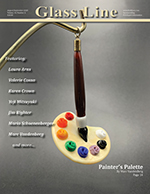
|
In This Issue
A Wind Chime or Furin by Yoji Mitsuyuki
In Japanese, fu means wind and rin means bell, so a wind chime is a furin.
Although a wind chime can be a bronze object that is used as a tool to repel plagues and demons that come with strong winds, it can also be a devilish tool during the hot season, when temperatures and humidity are high, bacteria can propagate easily, and diseases can spread. When the method of producing colorless transparent glass was introduced to Japan via the Netherlands in the 18th century (not by the ancient Silk Road), glasswork became popular in the Edo period of the 19th century. By the end of the Edo period, it was blown by Vidro and wind chimes made of glass were fashionable...

This year, our group of artists had been planning to create multiple collaborative works for a gallery show at a local museum. Unfortunately, the global pandemic has made it more difficult to continue that effort, and many people have turned to finding ways their art can help them through this time. After seeing photos of COVID art from around the world, I was inspired to try some myself. I make holiday ornaments every year for family and friends, and the form factor seemed fitting for producing a likeness of the virus. A lot of people are interested in acquiring these as a reminder of this time.
I felt a bit uneasy about making a profit on something that has caused so much pain and suffering, so I donate the profits from these ornaments to community organizations helping those in need right now. I hope readers will use this tutorial to help improve things in their own lives and communities as well...

I was first exposed to glassmaking as a child on family vacations. I never thought at the time it was in my future. I grew up in suburban mid-Michigan. The outdoors, music, sports, and surrealistic drawing made up much of my youth. I graduated from Michigan State University, majoring in video and television production. When my interest in glass was piqued on seeing glass pipes in local stores, I interviewed the chemistry department’s scientific glassblowers. At a time without the Internet, they became my source of information for supplies and where to begin.
With a friend who also shared an interest in glass and glass pipes, I purchased a small starter kit, including a National 3A blowpipe. My friend moved on to other interests but for me, it was the start of a passion. I went to the Library of Michigan, but found only three books about scientific glassmaking. I spent four years teaching myself, with lots of trial and error. At this, the beginning of my glass career, pipes were my art form and a means of self-expression...

Today, I happily consider myself half-artist and half-craftsman, and I like both worlds for their own reasons. Production is like my bread and butter — its consistent orders pay the bills; it’s generally low risk and can get boring making 100 of the same thing, but I like keeping the shops happy. Maintaining my relationships with them is incredibly important to me. I also like the artistic side, because I get the same feeling I got when I first started blowing glass: of making something I’ve never made before and having a challenge to overcome. The personal and financial rewards of taking those high risks can be great. Every once in a long while, I still think about how crazy it is that I blow glass for a living because I remember so clearly when it was such a far-fetched idea. Quitting has even crossed my mind a couple times, but I keep going. It goes to show that with relentless persistence, you can push through all your doubts.
It’s been a long, strange journey since I started blowing glass, with a lot of ups and downs, but it’s been so worth it. I’m so grateful to have met the many great people in and outside our glass community because of it. I wouldn’t trade it for anything else in the world. Keep the flame alive...

At the end of the workshop, I came out with a handful of glass beads, a small glass fish ... and the addiction to glass beads. It is all about the instructor being able to pass along their love and passion for what they teach; that is what helps and encourages students to want to continue learning the process.
That is what I try to emulate to my students — that glass is my passion, my therapy, my creative outlet. And that no matter how long you work in the process, there is always something new to learn.
My focus in glass now is to create 2,000 beads for Beads of Courage. I have sent in my first 1,000 beads and I am working on the next 1,000. Check it out: It’s a wonderful organization that donates beads to hospitals...

I’m self-taught, but that’s misleading. My teachers were the best of the best: forums, videos, blogs, magazines, and the Facebook lampworker community. As a rank beginner, I started by lurking and absorbing. Eventually, I became a newbie asking questions. Now I give back. My thank-you list for many wonderful teachers is long.
The generosity and goodwill of lampworkers sharing knowledge is the touchstone of this community. Whenever you get stuck, someone will help unstick you. Then comes practice, practice, practice. As one forum poster observed (paraphrasing), “Toss all your mistakes into your aquarium. When there’s no room for the fish, you’re getting better.”
My style is freeform, like painting. Flowers must look natural — wispy, perfectly imperfect, and breezy. Shadows and variations must be understated. You should see a flower, not a technique. The variations in color, vines, foliage, bead shape, and other objects in the garden are endless. Plant your garden your way...

Today, I find joy in giving. I make a lot of beads and I still get a huge kick out of it. I have also found new joy in giving knowledge. I started a YouTube channel where I teach my designs. I’ve been so tickled when I make a YouTube video featuring a particular design and other artists make that same bead and share on Facebook. It’s so funny being so proud of other artists making my little designs. I don’t even know these people; we’ve never met, but they all give me such a sense of happiness, especially since I know we all share our beads with Beads of Courage.
The philosophers out there will say, “Follow your joy.” My joy is in giving and making others smile.
Note: In this Tutorial I use hard glass to explain...
|
 June/July, 2020 - Vol. 34, No. 1.
June/July, 2020 - Vol. 34, No. 1.
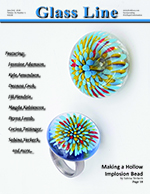
|
In This Issue

This demo uses a graphite skull push to create the illusion of a small skull encased in glass. I got my skull push from GnG Machine Works, but you could make your own from a graphite rod, or get creative and use a skull ring or something similar. Just make sure whatever you decide to use can take the heat.
Gather all the tools/materials you will need for this project — it is much more efficient to have everything ready than to go looking for something you need in the middle of a project. Pull the stringer for the eyes. Put the frit in the tray.
Always clean glass before putting it in the flame. I use isopropyl alcohol because it does not leave residue behind the way some glass cleaners can. I learned from Noah Drew that the difference between good glass and great glass is seconds: It takes a few seconds to clean glass, but it takes minutes to remove scuz trapped in the glass.
These skull marbles look really nice at 1.25”–1.5”, especially with a big lens to magnify the skull.
With marbles, it is always better to have a little more glass than you need. Removing glass is preferable to adding glass, at least when it comes to clear, due to the possibility of creating unsightly lens lines
...

Making frogs on a bead is insanely fun — or insanely frustrating, depending on your experience.
Why bother to make glass frogs to begin with? Some people find frogs adorable, but I also found an interesting article about the spiritual meaning of frogs: https://alltotems.com/frog-and-toad-symbolism-meaning-and-totem/.
One reason I prefer making frogs over other animals is that glass is the perfect material for the look of a frog’s body: no “fur” to simulate. It is also somehow super-satisfying to create a glass version of something that is alive. With every frog I make, I feel like I’ve “given birth” to something. Apart from that, beads with frogs sell well. How is that for an argument...

I find inspiration for my products mainly in nature, including a glamorous chateau park very close to my home. I try to capture colors, flowers, clouds, water, the play of shadows, on the relatively small surface of the bead ... all the impressions from taking walks with our Boston terrier Richie as my companion. That’s why I usually create my beads intuitively and according to my current mood; I don’t follow any formal procedures or tutorials.
I like the colors of the sunset, especially the beautiful reddish pink which can often be seen in the sky even at dawn. The sunset bead is a matter of my heart and I keep coming back to it because my customers like it. The production process is not complicated; you just have to be precise...

My main interest is in beadmaking; more specifically, hollow beads with techniques such as implosion and leaf beads. Almost all my beads are transformed in jewelry with stainless steel and silver accessories to become a ring, charm, necklace, earrings, etc., which I also do in my workshop. Once in awhile, I take a sidestep by creating glass sculptures. I love to practice making flowers and insects. I am certainly no expert in this, but I love to try...

I live in a western suburb of St. Louis, Missouri, called Wildwood. I am an insurance broker, a glass artist and I handle the advertising for digital publications of the International Society of Glass Beadmakers. I began melting glass more than 10 years ago. I have a small flameworking studio on the lower level of our home. Most days, you’ll find me down there creating something magical or … something for the water anneal jar, depending on the day. I seem to lean toward creating trees, flowers, and birds of prey.
I like to have a reference photo at hand when I am creating an animal or flower. I use my dry-erase board to capture my thoughts or tape up a printed photo nearby...

I have been working borosilicate for just over two years. After taking a lesson at the Mesa Arts Center, I was instantly hooked! I mostly enjoy making boro marbles and pendants, but I also work with soft glass beads occasionally. Currently my favorite thing to do is fumed and dichroic space theme marbles, but my inspiration is always changing, and I really enjoy spreading the love of glass art to the world...

In the late 1980s, my focus was sculpting native pieces. These can still be found at various cultural venues. When I was picked up by a gallery out of Yuma, Arizona, as a guest artist at exclusive showings, I knew I had found my path. After discovering a passion for molten glass, my work evolved into sculpturing miniature animals as wearable art forms that are realistic in flavor, each with its own characteristics.
When visiting Jamestown, North Dakota, in 1996, I saw a rare female albino buffalo calf named White Cloud. Her birth was widely celebrated by the Native American community. White Cloud is the inspiration for the creation of my white buffalo focal bead.
Creating a new piece finds me researching photos, skeletal structures, and colors. This leads to making several drawings and clay sculptures, and having photos to reference while I am at the torch. Creating the piece in clay beforehand is helpful for learning angles and techniques. Clay is more forgiving than glass when you are learning...

My first dragons were pipe and pendant embellishments until an online customer asked me to make him a business-card holder in the shape of the dragon in his logo. It took several days to make — my biggest project yet. I was so pleased with it that eventually I made more in my own style and a little smaller so I could complete them in less time and with less risk of breakage while sculpting...
|
 April/May, 2020 - Vol. 33, No. 6.
April/May, 2020 - Vol. 33, No. 6.
|

